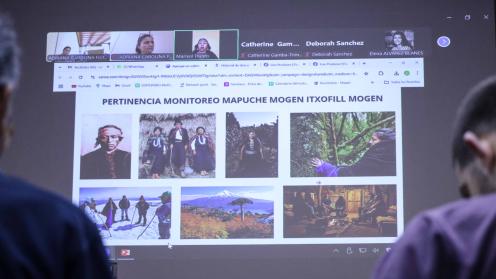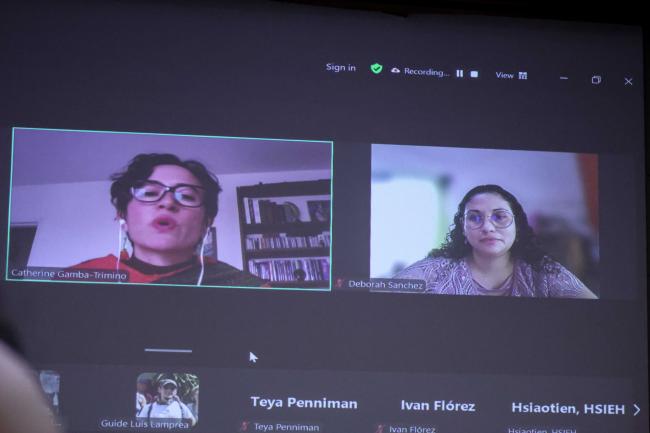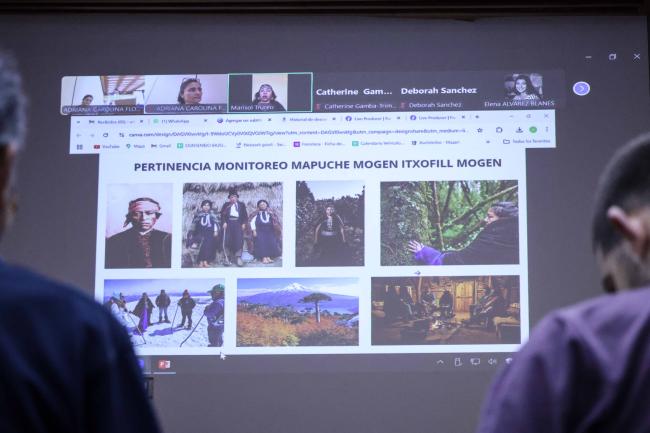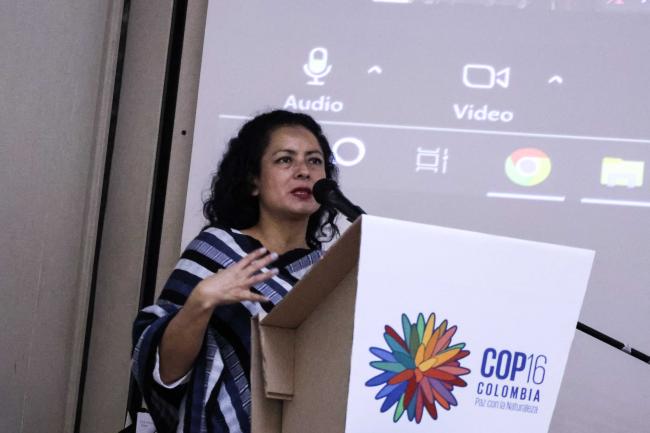About
Monitoring is essential for effective biodiversity conservation—and the Kunming-Montreal Global Biodiversity Framework (GBF) emphasizes the participation of Indigenous Peoples and local communities (IPLC) in this monitoring. This event featured the perspectives of Indigenous rights’ advocates, entrepreneurs, academics, and conservation practitioners on community-based monitoring for biodiversity conservation.
Catherine Gamba-Trimiño, Grupo de Reflexión, Estudio y Cooperación América Latina-Europa (GRECOL-ALC), moderated the event, which was held in person and via video conference. Adriana Carolina Flores-Díaz, Universidad Iberoamericana (IBERO), Mexico, assisted with the meeting.
Marisol Andrea Trureo Catilao, Pueblo Mapuche, Chile, said her people have a huge knowledge base from their natural context and they are “the guardians of biodiversity.” She noted that monitoring: allows them to understand the challenges and risks associated with harmful activities like pollution and climate change; helps them assess water quality in their area; and promotes participation in the management of the territories. She said collaboration between Indigenous Peoples and scientists can enrich the research, but also outlined the ways that extractive industries and economic and political systems harm their lives.
Deborah Sánchez, Director, Community Land Rights and Conservation Finance Initiative (CLARIFI), emphasized that mapping conservation areas can help confirm legal rights. She said incorporating traditional and cultural knowledge helps integrate new generations into the conservation process and provides opportunities to use technological tools for monitoring. She noted that data obtained can allow the territory and community to make informed decisions, including priority-setting for conservation work. She highlighted an early alert system, including the use of satellites and drones, as an example of connecting traditional knowledge and modern technology.
Paulina G. Karim, Forestry and Nature Conservation Agency, Taiwan, shared two maps that showed an overlap of biodiversity hotspots and areas being managed by Taiwan’s Indigenous communities. She said this indicates that Indigenous Peoples have conserved and managed the area in a sustainable manner. Karim highlighted the use of resilience assessments, which use 20 indicators, and described them as “health checks” for both communities and ecosystems. She noted that IPLCs are most affected by the triple planetary crisis of pollution, biodiversity loss, and climate change, and that monitoring goes “beyond the here and now.” She explained that the community members who do the monitoring also exchange the knowledge with each other, which fosters conservation priority setting for their community.
Flaviano Mahecha Avila, community leader, Amazonia Colombiana, shared his work with large landowners in the Colombian Amazon, focusing on sustainable harvesting practices that respect Indigenous knowledge. He noted that the community is compensated for their harvests, and these agreements help “preserve the forest as a friend, not an enemy.” He said an approach that allows the community to make use of forest resources without damaging the forest combines traditional knowledge with regulated resource use.
Yesenia Hernández, International Indigenous Forum on Biodiversity and Ecosystem Services, and Biodiversity Finance Initiative, focused on the value of Indigenous knowledge for biodiversity conservation, saying that Indigenous Peoples have been conserving ecosystems long before other scientific methods. She said having direct information allows the community to identify changes in nature. She stressed the need for free, prior, informed consent related to data sharing and highlighted challenges related to the technical language. She shared the experience of using GPS technology for monitoring that helped inform conservation efforts for wildlife and emphasized the need for policies that recognize and support Indigenous-led monitoring efforts.
Imran Gündüz Alptürker, Mersin University, Turkey, emphasized that the Yuruk people preserve their intangible cultural heritage through their nomadic lifestyle, which revolves around wool production and sustainable practices that support biodiversity and their way of life. She highlighted the role of traditional ecological knowledge, which is passed down and remains central to the Yuruk’s identity. Noting the challenges in monitoring due to their nomadic nature, she said the Yuruk monitor in their own region and that their movement patterns are essential for ecological balance.
Other topics raised during the discussion included:
- how Indigenous knowledge can enhance scientific conservation methods;
- concerns about who owns and controls the data collected from their lands;
- barriers to recognition that Indigenous communities face in securing rights and acknowledgment of their conservation work;
- the need for policies that reflect and respect Indigenous contributions;
- the need for financial mechanisms, such as ecosystem service payments, to sustain community-led conservation efforts;
- the importance of training and access to technological tools to enhance monitoring capabilities and empower local conservation efforts;
- the right to manage their territories and protect resources according to their own cultural values;
- examples of successful collaboration and the need for more partnerships; and
- the temporal dimension that goes backwards to the ancestors, and forward to the children and grandchildren, and how the commitment to maintaining this biodiversity for generations to come is very strong.
Organizers: El Centro Transdisciplinar Universitario para la Sustentabilidad (CENTRUS) de la Universidad Iberoamericana, GRECOL-ALC, and la Alianza para el Financiamiento a la Conservación y Restauración Comunitaria de la Biodiversidad
Contacts: Adriana Flores Díaz adriana.flores@ibero.mx
For more information: https://cop16.humboldt.org.co/
To receive free coverage of global environmental events delivered to your inbox, subscribe to the ENB Update newsletter.
All ENB photos are free to use with attribution. For the 2024 UN Biodiversity Conference, please use: Photo by IISD/ENB


















